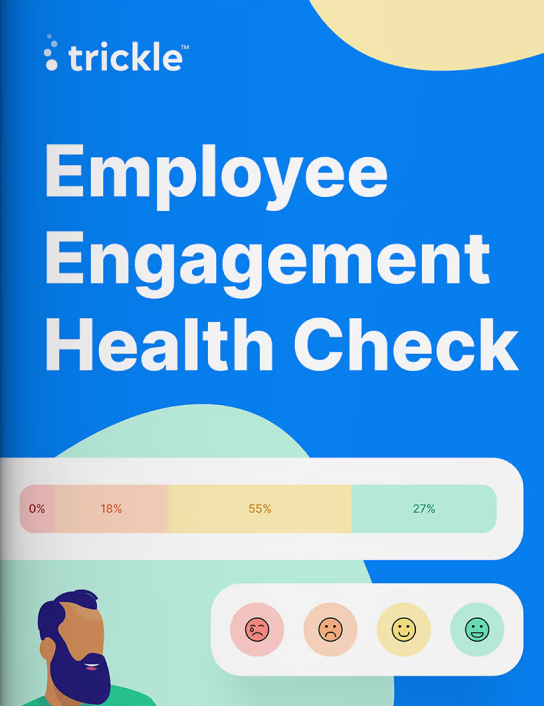How well does your company engage its employees?
Take your health check and find out.


Read about Trickle’s recent webinar discussion with Iris Software about how to prepare for the future of work, especially after COVID-19.
The future of work looks similar to the present. Hybrid or remote working is now becoming increasingly normalised across the globe, with 46% of workers stating they would consider quitting if they couldn’t work remotely. But what impact does this have on the other aspects of work? How can companies ensure that this new way of working works for them?
Our founder CEO Paul Reid was part of a webinar with Stephanie Kelly, Chief People Officer of Iris Software Group; Sara Lewis, Head of Communications for Iris Software Group; and Jill Christensen, an employee engagement expert, author and keynote speaker. They had a great discussion about what the future of work looks like for both employers and employees.
We’ve summarised the topics that they spoke about in this article or you can watch the on-demand webinar by clicking the banner below.
As much as we believe that remote and hybrid working is a great thing, it does have its downsides. When everyone is in different locations around the country or, in some cases, the world, it’s more difficult for employees to observe each other passively. Spontaneous interactions are harder to come by.
What is an effective way of communicating in the office isn’t always possible remotely. The definition of ‘effective communication at work’ needs to be updated to include methods that are suited for remote and hybrid working.
It’s easy for employees to become a little disconnected without realising it. A solution to this problem is everyone being more deliberate in their communication.
Leaders can lead by example much easier in a physical office setting, where staff are able to see them carrying out their daily tasks and how they interact with everyone. Remote and hybrid working diminishes this. Now, leaders must be more thoughtful about their actions. They must ensure that employees see that they are doing their best by making time to check in with staff and being more active on company social media channels.
In addition to this, management must now look into scheduling social time. It may seem a bit forced, but it’s still a good way of ensuring everyone isn’t stuck in their own world.
Another aspect to watch out for is the lack of non-verbal communication via a Zoom call or Slack message. A large part of the way we communicate is non-verbal, with intonation, body language, eye contact being vital to getting a message across and interpreting messages accurately. These can easily be misinterpreted, or missed altogether on a Zoom call.
As the number of companies that offer either hybrid or remote working increases, it becomes less impactful to include this as a benefit when recruiting.
If your organisation offers remote work within a certain region, e.g. Europe, or globally, then this can be seen as a perk. This is because the number of companies able to offer this level of flexibility is still small, as the shift to new working models is still in its infancy.
Companies need to find other ways of differentiating themselves from their competitors. The job market has shifted and, at the time of writing, the job market in many countries is strongly in favour of job seekers. Focusing on empathy, internal culture, and purpose are now becoming more important for any business that wants to differentiate itself from its competitors. A more human-centric approach will go a long way towards improving acquisition and retention metrics as well as the overall employer brand.
Remote working gives employees more freedom to arrange their workday as they see fit. Some people may not read emails until 11 am, some might start late and work later than their colleagues, others have to plan around children. It’s important that there is a healthy balance between individual flexibility and overall business structure. Expectations on what is expected when working remotely should be made clear and constantly updated to keep pace with any changes.
An employee experience platform such as Trickle is a great way of keeping track of how employees are responding to any changes that are made. It also gives them a chance to be involved in the process of creating internal policies.
Whilst remote working has put a lot of UK office space under threat, there is still a place for it. Digital tools such as Slack, Microsoft Teams, and Google Suite enable employees to collaborate from virtually anywhere with a stable internet connection. However, as good as these tools are, it’s still nigh on impossible to replace the quality of interaction and collaboration that happens in person.
That’s where the office comes in. Remember the water cooler in the office before the world turned upside down? Think of the office as being the new water cooler. Instead of the office being a place to get work done, it’s now a place to meet in person, socialise and collaborate.
Working from home or wherever employees feel most comfortable will be the place to lock in, block out the world and get things done. Employers should respond to this by adapting their existing office spaces or moving into a new location that is better suited for this way of working.
Remote and hybrid working is here to stay. 85% of workers want, at minimum, a hybrid approach to work. To implement that effectively, it’s even more important that your employees are closely involved in decision-making and highly engaged. Trickle can help you to do this and much more.
Click the link below to get your free demo today.